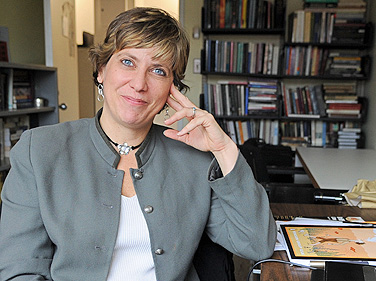Close Up
Mazzio’s work links math, literature

Carla Mazzio says that while “nothing quite spoke to me like poetry and literature,” she also has a passion for math. Photo: NANCY J. PARISI
When UB’s English Department lured Carla Mazzio to Buffalo in 2008, “it was with the sense of pulling off a major coup” that administrators made the hire. Mazzio had been honored by the Hudson Strode Program in Renaissance Studies as one of “the most brilliant Renaissance scholars in the world under the age of 40.” A 1998 graduate of Harvard University’s highly regarded English and American Literature PhD program, she had published frequently and to great acclaim.
Tim Dean, professor of English and director of the Humanities Institute in the College of Arts and Sciences, shared those comments one recent Friday afternoon with a crowd gathered at the Albright-Knox Art Gallery to hear Mazzio, an institute research fellow and associate professor of English, speak as part of the Scholars at Muse lecture series. As she delivered a talk entitled “Shakespeare’s Math,” it was easy to understand why colleagues view her as an asset. Beyond intellect, Mazzio possesses an unusual, lilting charisma. After wrapping up prepared remarks, she engaged in lively banter with members of the audience, showing genuine interest in their questions and ideas—so much so that Dean had to cut off the discussion as time reserved for the event ran out.
In a world where problem-solving and the advancement of knowledge often require teams and thinkers working across disciplines, Mazzio is a faculty member positioned to succeed: A highly respected scholar still early on in her career with a collaborative nature and an eclectic list of research interests that ranges from 16th and 17th century English and European literature to the history of the book and the history of science, medicine and mathematics.
This year, alongside publishing “The Inarticulate Renaissance: Language Trouble in an Age of Eloquence”—nominated for the Phyllis Goodhart Gordan Prize for the year’s Best Book in Renaissance Studies—Mazzio edited and contributed to “Shakespeare & Science.” This latter volume, a special double issue of Johns Hopkins University’s South Central Review, explores links between Shakespearean drama and anatomy, cartography, botany, physics, cosmology, meteorology, experimental science and early variants of life science. In a related project, she is working on a book examining how irrational dimensions of mathematics affected aesthetic innovation during the Renaissance. She will discuss this new work as the keynote speaker at the University of Michigan’s upcoming Conference on Early Modern Art and Science.
Mazzio says that while “nothing quite spoke to me like poetry and literature,” she has long harbored a passion for math. Her longstanding interests in science, as well as literature, have fueled papers, books and presentations demonstrating connections between her two seemingly disparate loves. In her recent talk at the museum, she pointed out that in early Renaissance math books, equations and procedures often were accompanied by stories, dialogues and narratives, some of which highlighted the tragic or comic consequences of an individual’s inability to do math very well.
Conversely, Renaissance dramas often drew upon tensions integral to the culture of mathematics that was emerging at the time—as well as details from math books themselves—in ways that scholars have not yet fully realized. While math often is associated with order, reason or the rise of rationalism, it was, in its early days, also a source of disorder and frustration as people struggled with the unfamiliar discipline. Mazzio’s museum talk analyzed Shakespearean drama—and Hamlet in particular—in light of problems linked to mathematics.
"If we, as humanities scholars in particular, understand the extent to which early math was as much about passion as reason, about disorientation as orientation, about disorder as order, we can begin to see relationships between math and various art forms, and early drama in particular, in new ways,” she says.

Reader Comments